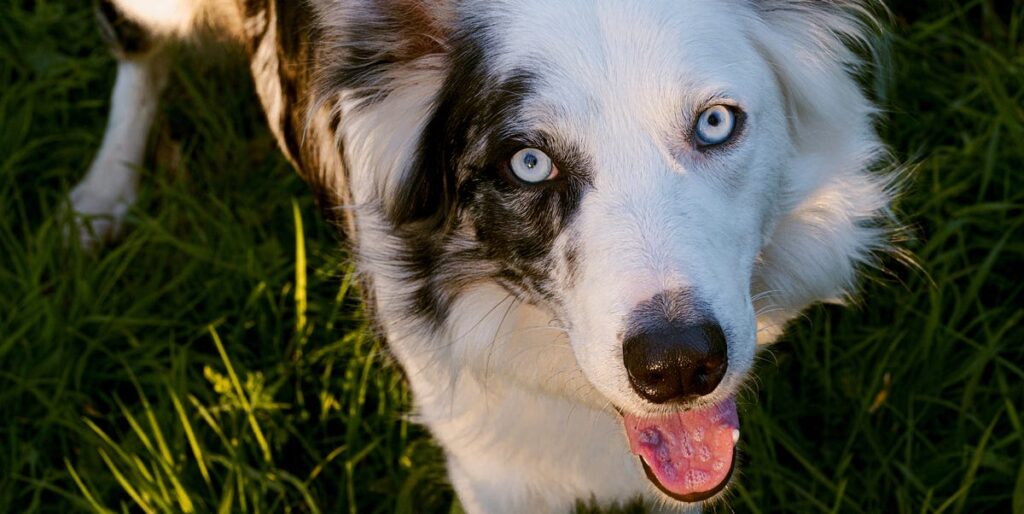Siberian Husky
The breed of man’s best friend most famed for his blue eyes has got to be the Siberian Husky. According to Dr. Rebecca Greenstein, Veterinary Medical Advisor for Rover: “About 50% of Huskies have those classic, ice blue eyes that we’ve come to associate with this arctic breed. Fortunately, the gene responsible for those beautiful peepers in this breed isn’t typically linked to health conditions like deafness.” Spirited but tender-hearted, these pack dogs bred pull to sleds make great pets for active families that can provide the daily exercise they require.
Group: Working Height: 21–23.5 inchesWeight: 45–60 pounds
Energy level: High Life Expectancy: 12–14 years
Shetland Sheepdog

Pining for a chipper and clever Sheltie with bright blue eyes? You’re in luck because it’s not an unusual trait in this breed. “Shetland Sheepdogs that are merle in color may have one or two blue eyes,” Dr. Dockweiler says. “This is permissible in the show ring in these individuals. About 30% of the Shelties in the Embark database are merle in color.” A cousin to the Collie, but smaller, Shelties were developed on the U.K. islands from which they take their name to herd livestock. They’re both sunny-natured and sensitive dogs, great with kids and other pets.
Group: HerdingHeight: 13–16 inchesWeight: 15–25 poundsEnergy level: HighLife Expectancy: 12–14 years
Related: Dog Breeds Perfect for Farms and Ranches
Advertisement – Continue Reading Below
Corgi

Whether you opt for a Pembroke Welsh Corgi or a Cardigan Welsh Corgi, you’ll be getting an industrious, alert and agile pup that is both independent and highly affectionate. And it shouldn’t be too difficult to find one with sky-colored irises. “Blue eyes are common in Corgis, especially in Cardigan Welsh Corgis with merle coats,” notes Dr. Gabre Denton, Pet Trainer and Veterinarian with TeachMe.To. “It’s less common in Pembrokes, but either way, these smart, fun dogs make great pets. They have loads of character and are very lovable.”
Group: HerdingHeight: 10–12 inches (Pembroke); 10.5–12.5 inches (Cardigan Welsh)Weight: up to 30 pounds (Pembroke); 30–38 pounds (Cardigan Welsh)Energy level: Medium Life Expectancy: 12–15 years
Old English Sheepdog
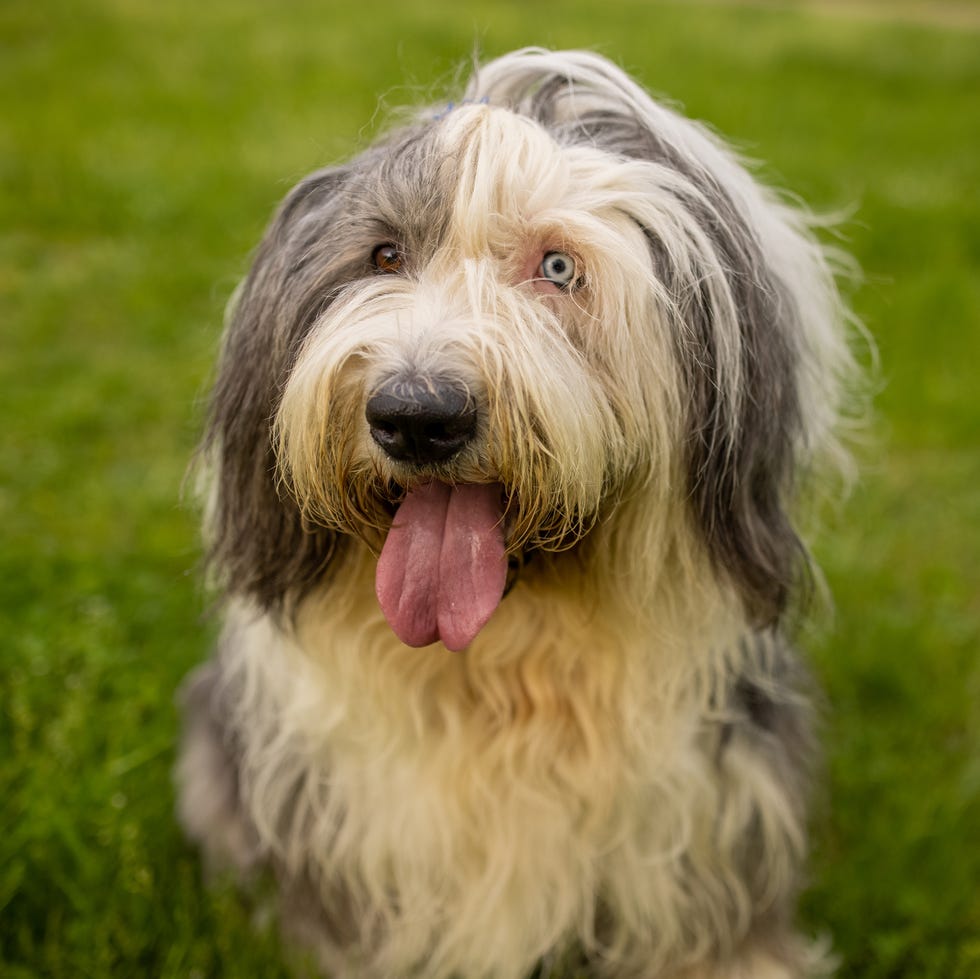
Used as cattle drovers throughout England’s west in the 18th century, the Bobtail, as he’s also known, is a shaggy, sociable fellow who can be found with blue eyes…if you can find them beneath all that hair, that is. “Blue eyes are sometimes seen in the Old English Sheepdog, likely due to a large amount of white patterning,” Dr. Dockweiler explains. “Their American Kennel Club breed standard specifies eye color in this breed may be either brown or blue.” This very good boy is a solid choice for a family, as long as they have the time it takes to attend to his daily grooming needs.
Group: HerdingHeight: 22 inches and upWeight: 60–100 poundsEnergy level: MediumLife Expectancy: 10–12 years
Advertisement – Continue Reading Below
Australian Shepherd
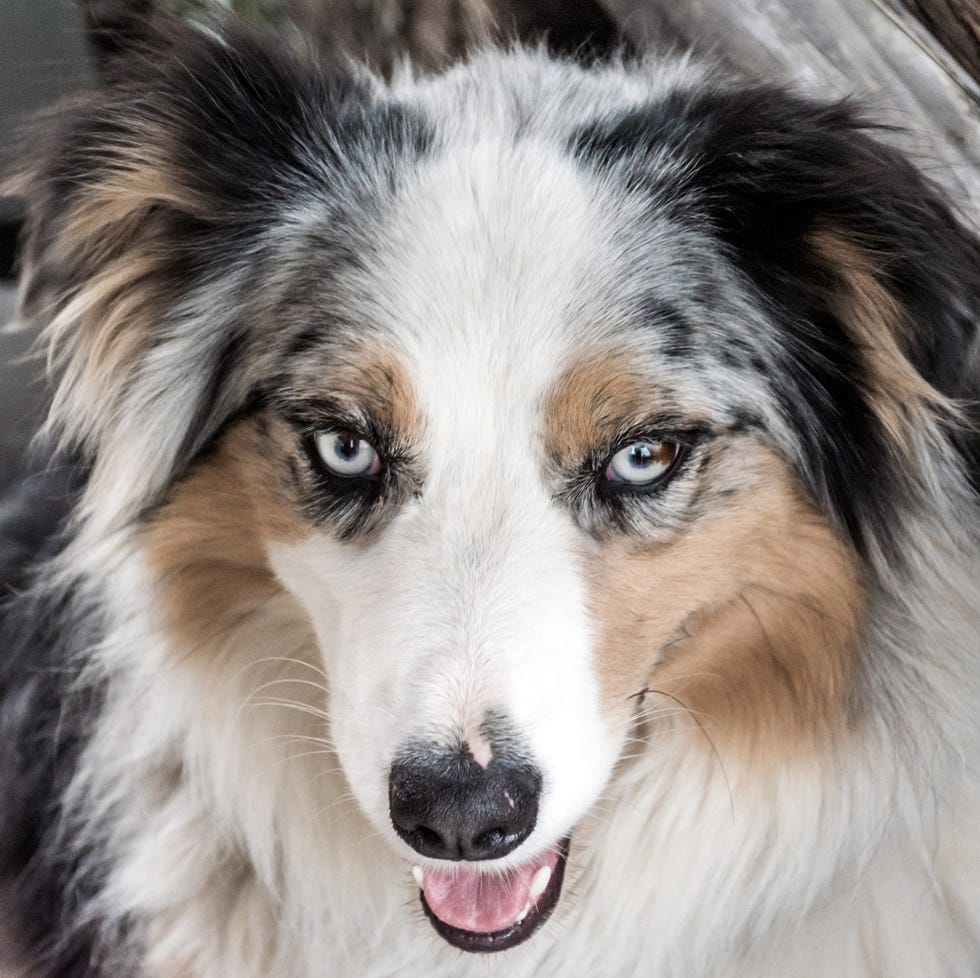
A favorite of American cowboys, this super smart and endlessly energetic herding canine has also been employed as police and search-and-rescue dogs, as well as aides for the differently-abled. “Many Aussies have blue eyes, and this trait can occur alongside any coat color, but it’s more commonly seen in dogs with that distinctive merle coat,” says Dr. Greenstein.” If a dog has two copies of the merle gene [the gene that gives many Aussies their multicolored merle hair color], eye and other defects can result. These issues can often be prevented by avoiding breeding two merles with one another. “
Group: HerdingHeight: 20–23 inchesWeight: 50–65 poundsEnergy level: HighLife Expectancy: 12–15 years
Catahoula Leopard Dog

The only canine to originate in Louisiana, the Catahoula Leopard Dog takes his name from the Choctaw word for “sacred lake.” A herding breed with Mastiff, Bloodhound, and Greyhound ancestry, Catahoulas are protective, making them good guard dogs. Blue eyes are not unexpected in this unique breed, according to Dr. Dockweiler. “Many Catahoula Leopard Dogs are ‘leopard’ in color, caused by the same gene mutation as merle in other breeds,” she says. “About 80% of Catahoulas in Embark’s database have at least one copy of the merle gene. As a result, many Catahoulas also have blue eyes; in fact, very light blue [or ‘glass’] eyes are preferred in this breed.”
Group: Not recognized by the AKCHeight: 22–24 inchesWeight: 50–95 poundsEnergy level: HighLife Expectancy: 12–14 years
Advertisement – Continue Reading Below
Dalmatian
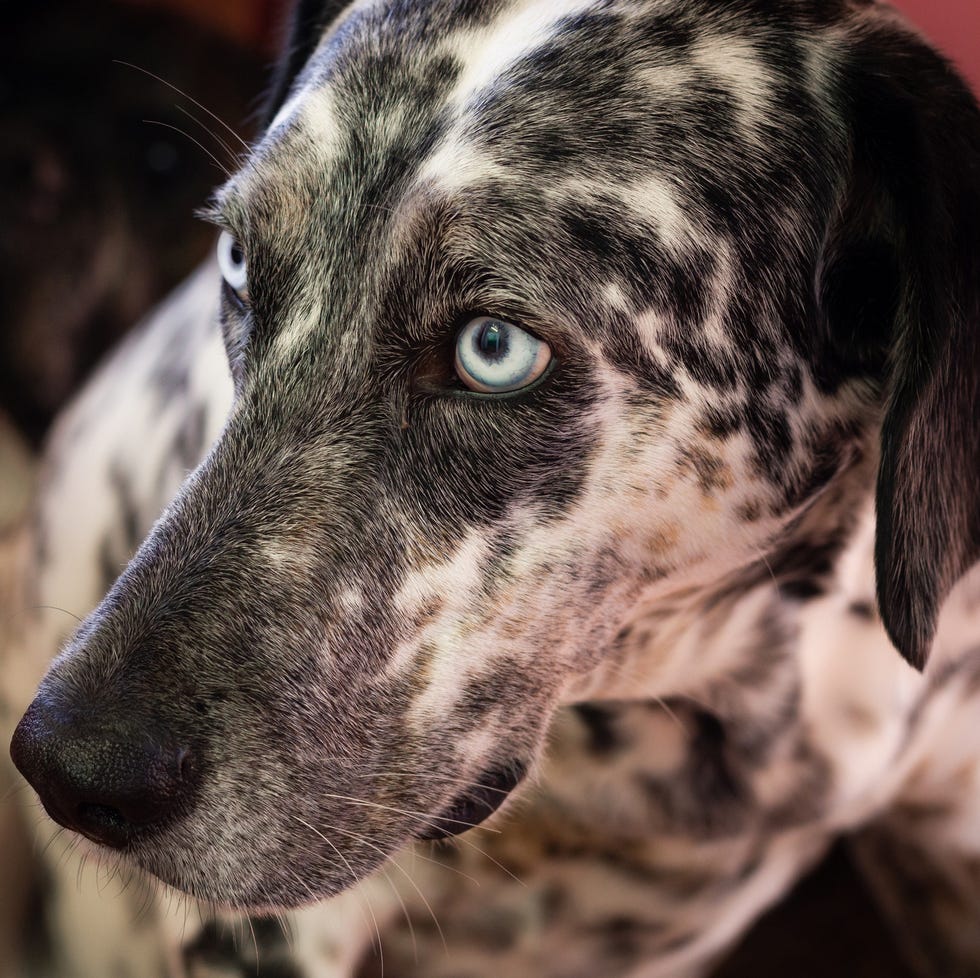
Long associated with firehouses, this athletic and dignified breed is distinctive-looking enough even without dramatically colored eyes. But should you have your heart set on a Dalmatian with blue eyes, Dr. Denton says they do occur in the breed, although not as frequently as do brown eyes. “Unfortunately Dalmatians are one of the breeds that do have a higher rate of inherited deafness than other breeds,” Dr. Denton adds. “When they have blue eyes this can be an indicator for inherited deafness, so best to have your vet check them out if concerned. Either way, they are going to be full of energy and character.”
Group: Non-SportingHeight: 19–24 inchesWeight: 45–70 poundsEnergy level: HighLife Expectancy: 11–13 years
Pomsky
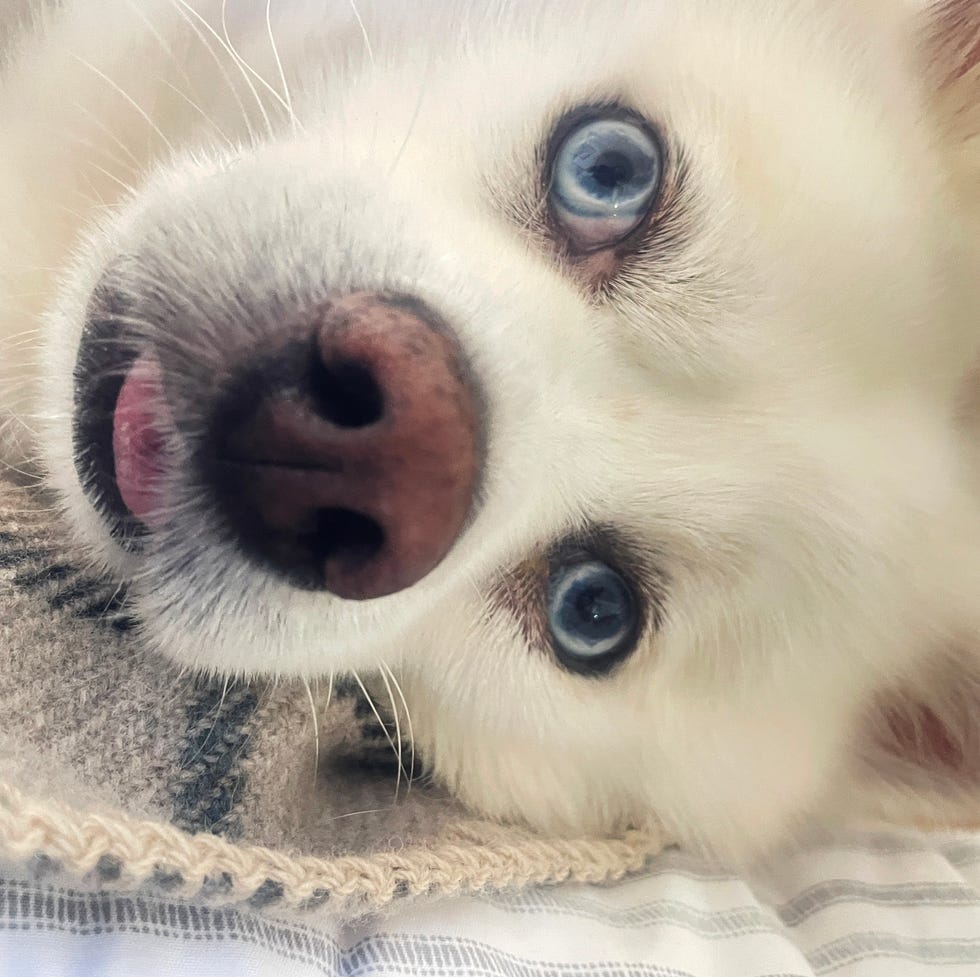
A cross between a Siberian Husky and a Pomeranian, Pomskies are itty bitty fluff balls that are still relatively rare and therefore usually pricey to purchase, especially if you want one with blue eyes. Prone to barking and protective, they don’t typically make great pets for parents with young children, but other families will find these dogs loving and fiercely loyal, along with plenty playful (lots of regular exercise is a must). Dr. Greenstein notes, “Blue-eyed Pomeranians are exceedingly rare. However, given the prevalence of baby blues in Huskies, it’s possible for the gene to be passed to the offspring of these so-called designer dogs.”
Group: Not recognized by the AKCHeight: 10–15 inchesWeight: 20–30 poundsEnergy level: High Life Expectancy: 13–15 years
Related: Protective Dog Breeds that Make Loyal Pets
Advertisement – Continue Reading Below
French Bulldog

The most popular dog breed in America, the famously charming and companionable French Bulldog is a wonderful choice for families who’d like a pooch with Paul Newman-esque eyes. According to Dr. Dockweiler, “Frenchies may have blue eyes for a few different reasons. First, piebald (white-spotted) Frenchies are likelier to have blue eyes than their solid counterparts. Second, merle French Bulldogs have recently become very popular in the pet market, and are more likely to have blue eyes than Frenchies of other colors. While piebald is acceptable in the show ring, both merle and blue eyes are not. In Embark’s database, approximately 20% of Frenchies are merle and 10% are piebald. “
Group: Non-SportingHeight: 11–13 inchesWeight: Under 28 poundsEnergy level: LowLife Expectancy: 10–12 years
English Setter

First bred some four centuries ago in Great Britain as a hunting dog, English Setters are friendly and fun canines that also exude elegance. As for the possibility of pretty peepers, according to Dr. Denton, “English Setters usually have warm brown or hazel eyes, with blue eyes being less common. These are another breed that is at higher risk of inherited deafness, and blue eyes and a whiter coat can be an indicator of that. These sweet, speckled dogs are known for being affectionate and great with families.”
Group: SportingHeight: 25–27 inchesWeight: 65–80 poundsEnergy level: HighLife Expectancy: 12 years
Advertisement – Continue Reading Below
Alaskan Klee Kai

The Alaskan Klee Kai is a small, sharp-witted and sprightly breed that takes well to training, makes a good watchdog and likes to stick close to his family. Developed in the early 1970s, they remain rare, but when found, often have blue eyes. “Any eye color is acceptable for Klee Kai in the show ring, and most blue eyes in this breed are caused by the same ALX4 gene mutation found in Huskies,” says Dr. Dockweiler. “This makes sense, given Siberian Huskies were used to create the Klee Kai! About 60% of Klee Kai in Embark’s database have at least one copy of the gene associated with blue eyes.”
Group: Not recognized by the AKCHeight: 15–17 inchesWeight: 16–25 poundsEnergy level: HighLife Expectancy: 13–16 years
Border Collie

Extremely active and agile mentally as well as physically, Border Collies were traditionally bred to herd livestock in the border region between Scotland and England. They can be a handful, but nowadays are beloved as family pets across the U.S. “Most Border Collies are typically dark-eyed, but a smaller percentage of the population can be seen with either one or both eyes being blue,” says Dr. Greenstein. “Like Aussies, the double merle gene has been linked to concurrent eye and hearing concerns. These dogs are clever, hard-working, and have seemingly boundless energy!”
Group: HerdingHeight: 18–22 inchesWeight: 30–55 poundsEnergy level: High Life Expectancy: 12–15 years
Advertisement – Continue Reading Below
Great Dane
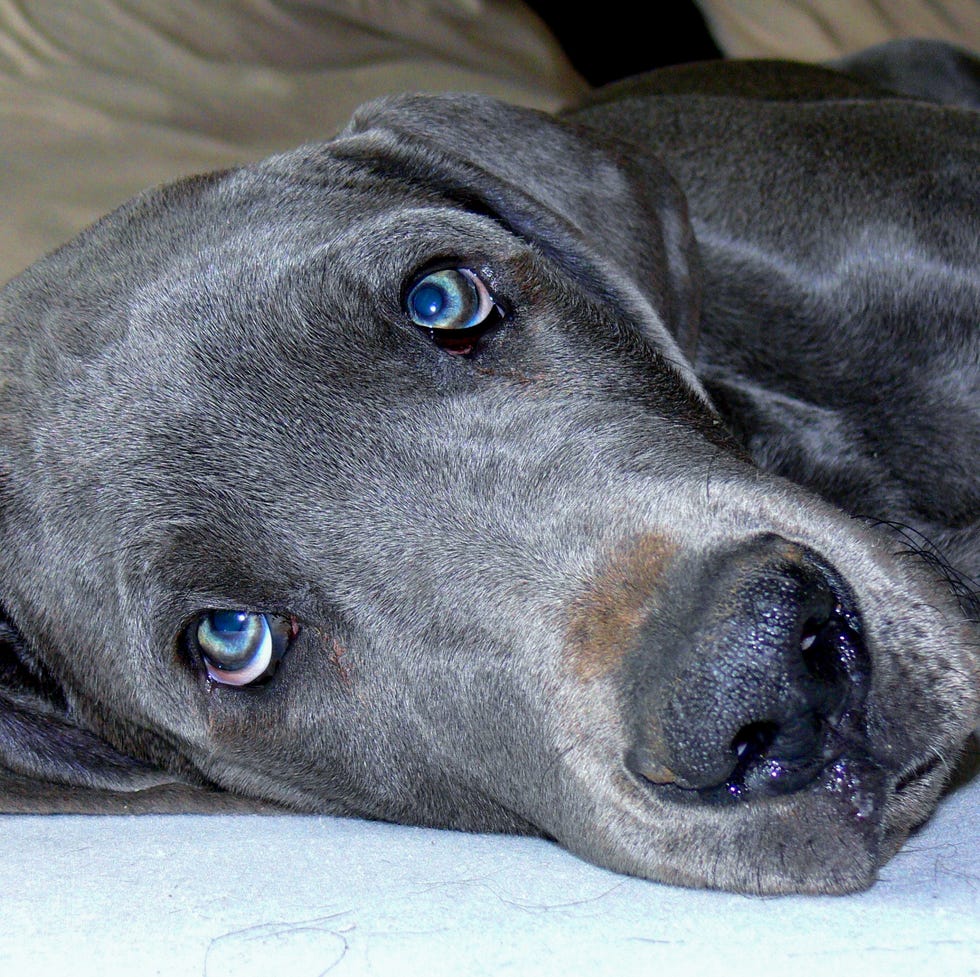
This (very) big boy, which hails from German rather than Denmark, is a true gentle giant, with a patient, even benevolent temperament. As long as you’re not an intruder, that is—Danes have a reputation as skilled watchdogs. They also can sport blue eyes, as Dr. Dockweiler notes, “In the Great Dane, blue eyes are permitted in the show ring in both the harlequin and merle coat patterns. These coat patterns occur in about 40% of Embark-tested Danes.”
Group: WorkingHeight: 30–32 inchesWeight: 140–175 poundsEnergy level: LowLife Expectancy: 7–10 years
Related: Large Dog Breeds to Consider Adding to Your Family
American Pit Bull Terrier

Perhaps the world’s most unfairly maligned canine due to its tragic and cruel history in dog fighting rings, Pitties in fact make wonderfully steadfast, sweet-natured additions to the household. The breed’s ancestry, which dates back to early 19th-century England, includes Terrier and Bulldog bloodlines. Along with heterochromia (two different colored irises), “Pit Bulls can have blue eyes, especially as puppies,” says Dr. Denton. “They can retain these but they often change to a darker color as they mature. Pit Bulls are extremely affectionate and loving dogs,” he adds. “With good early and continued training, they make great family pets.”
Group: Not recognized by the AKCHeight: 18–21 inchesWeight: 35–70 poundsEnergy level: MediumLife Expectancy: 8–15 years
Advertisement – Continue Reading Below
Weimaraner
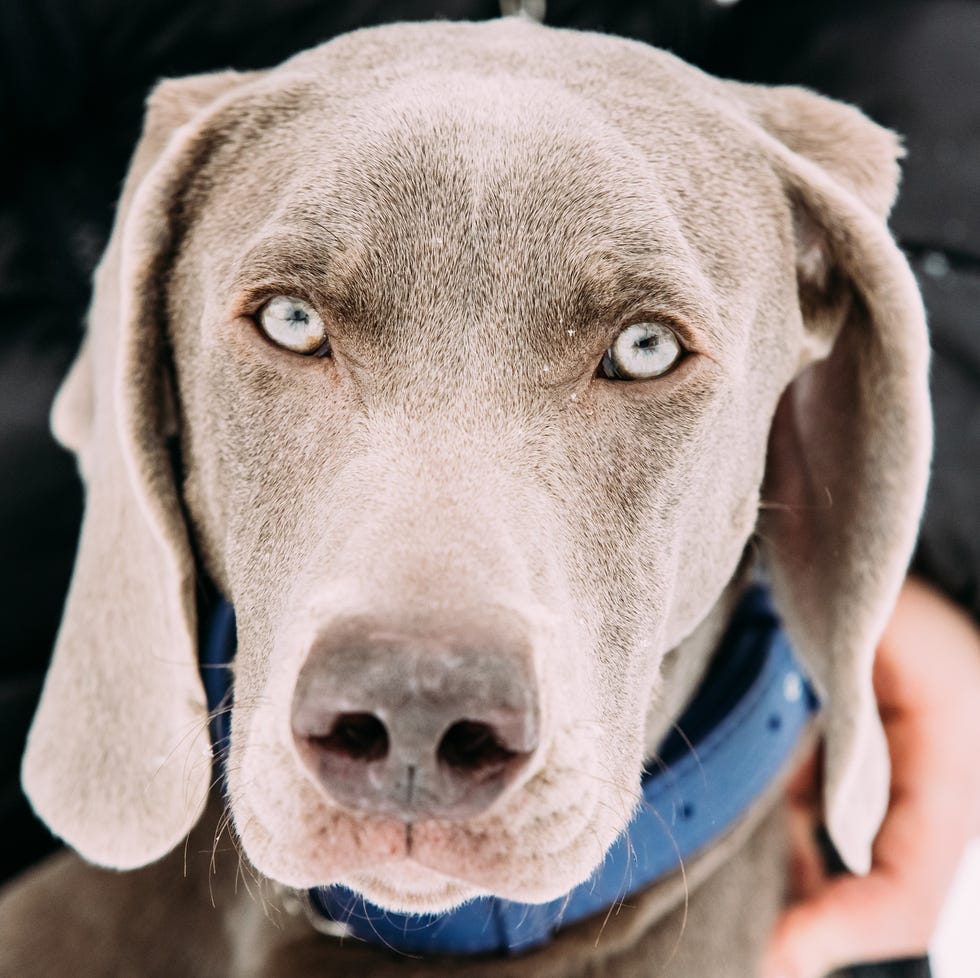
With their unique and absolutely stunning silvery-gray coat color, Weimaraners with blue eyes are an especially striking sight. “Weimaraners are known for their iconic amber eyes, but they can sometimes start out blue as puppies,” Dr. Greenstein confirms. “These sporting dogs were originally bred in Germany for hunting and while smart, can be stubborn!” Nonetheless, this breed makes a devoted (and easy-to-groom) family member that is particularly good with the littles.
Group: SportingHeight: 25–27 inchesWeight: 70–90 poundsEnergy level: High Life Expectancy: 10–13 years
Cane Corso
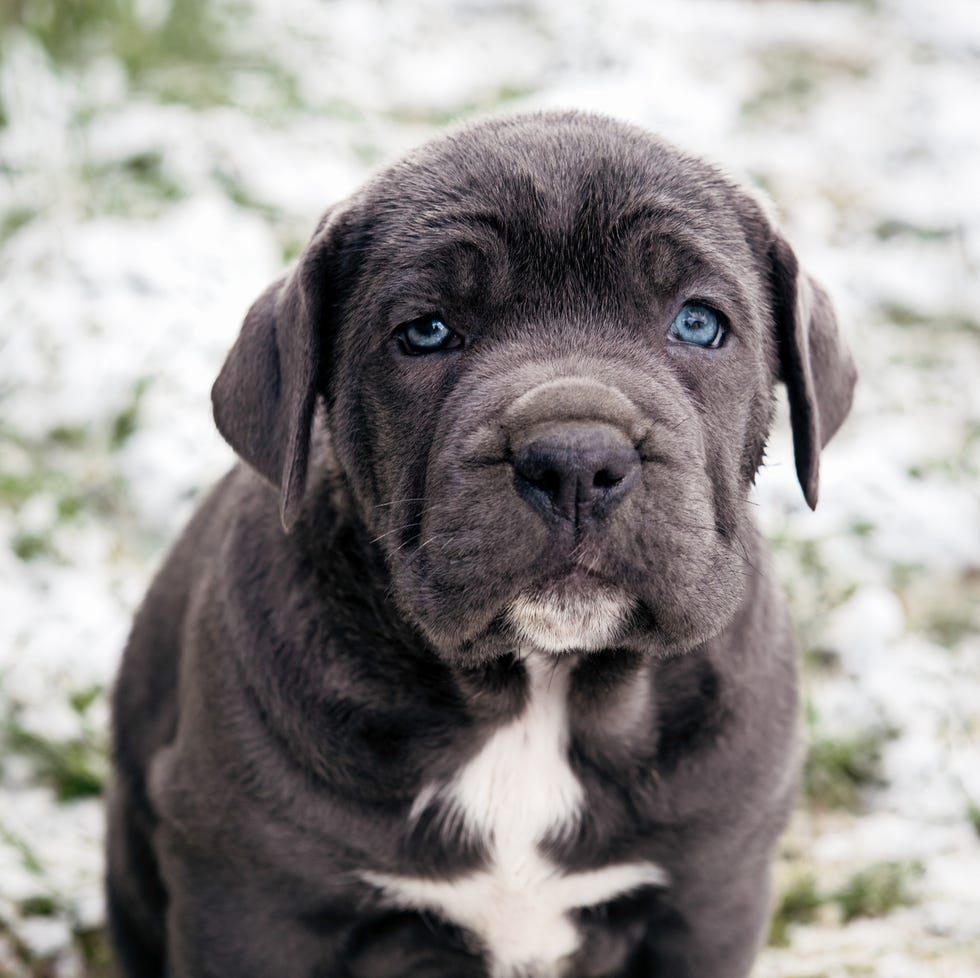
While you might be lucky enough to find a Cane Corso with blue eyes, but be aware that it’s an uncommon hue in this massive, majestic breed and, as Dr. Dockweiler, notes, “a disqualification in the show ring. Many Cani Corsi are gray in color, which means their eyes can be a light amber, yellow-green, gray, or copper color,” she adds. No matter the look of their eyes or coats, you bet this former Roman war dog will be quick-witted, eager to please and a staunch defender of hearth and home.
Group: WorkingHeight: 25–27.5 inches Weight: 80–120 poundsEnergy level: MediumLife Expectancy: 9–12 years
Advertisement – Continue Reading Below
Shih Tzu
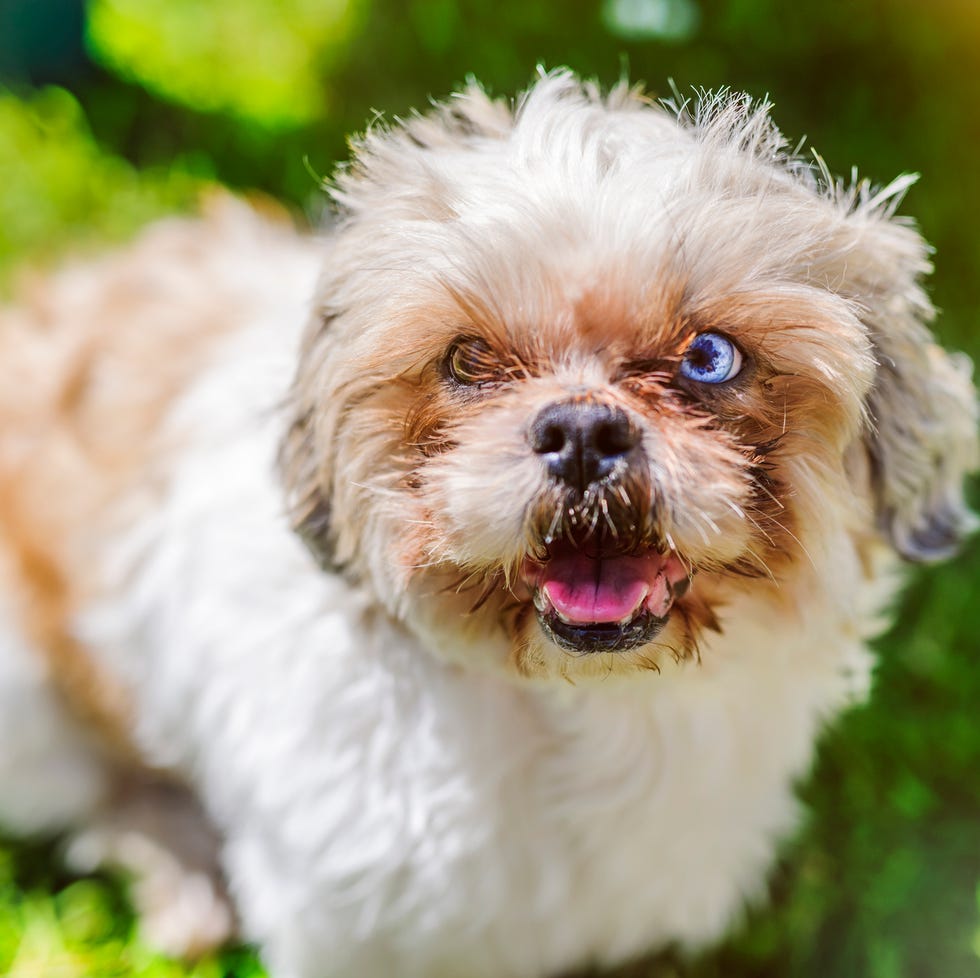
A companion to Chinese emperors for centuries, Shih Tzus are affable little lap dogs great for those who live in smaller homes. Just be wary of a health issue that can pop up in dogs of this breed with blue eyes. “White spotting is common in the Shih Tzu, and about 50% of Embark-tested dogs of this breed are expected to have a large amount of white,” says Dr. Dockweiler. “This is likely why some Shih Tzus have blue eyes, though it is a fault in the show ring. Another potential cause for very light blue eyes in this breed is Oculocutaneous Albinism. This is an inherited condition that leads to an all-white coat as well as a pale eye color. Unfortunately, dogs with this condition are prone to developing certain types of tumors (such as melanoma) on their skin and the colored parts of their eyes.”
Group: ToyHeight: 8–11 inchesWeight: 9–16 poundsEnergy level: MediumLife Expectancy: 10–16 years
Related: Lap Dogs Perfect for Cuddling
Labrador Retriever

The most popular dog in America for 31 years running (until they were knocked from the top spot by the winsome Frenchie), Labs come from Canada’s Newfoundland, not Labrador. Traditionally waterdogs, they make excellent service animals and are beloved for their kindly, easygoing, and adaptable disposition. Though rare, some Labs do have blue eyes, which Dr. Dockweiler says occur by an unknown mechanism. “‘Charcoal’ or ‘Silver’ Labs have a dilute coat color and may have very light green or gray eyes,” she adds. “It’s important to note that this coat color is not accepted by the American Kennel Club.”
Group: SportingHeight: 21.5–24.5 inchesWeight: 55–80 poundsEnergy level: HighLife Expectancy: 11–13 years
Advertisement – Continue Reading Below
Dachshund
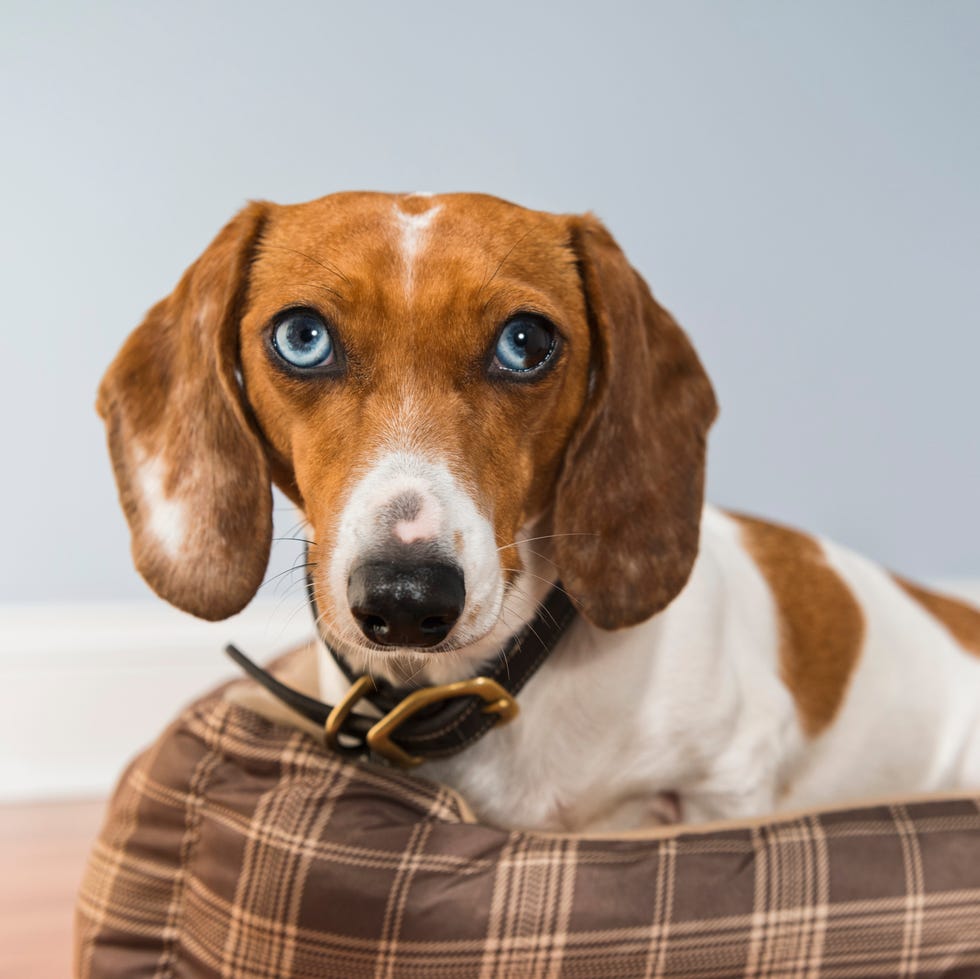
The sociable, spunky little wiener dog comes in two sizes and three different coat types. Short of leg and long-backed, they were hunting badgers in Germany some six centuries ago and are still known for their outsized courage to this day. “Dachshunds do not commonly have blue eyes, but when they do this will typically be coupled with a dapple coat,” says Dr. Denton. “The dapple gene brings unique patterns but can come with some health risks including a higher chance of deafness and blindness. Dachshunds are a fantastic breed with a lot of curiosity and loyalty.”
Group: HoundHeight: 8–9 inches (standard); 5–6 inches (miniature)Weight: 16–32 pounds (standard); 11 pounds and less (miniature)Energy level: MediumLife Expectancy: 12–16 years
Related: Dog Breeds with Short Legs that Make Great Pets
Alaskan Malamute
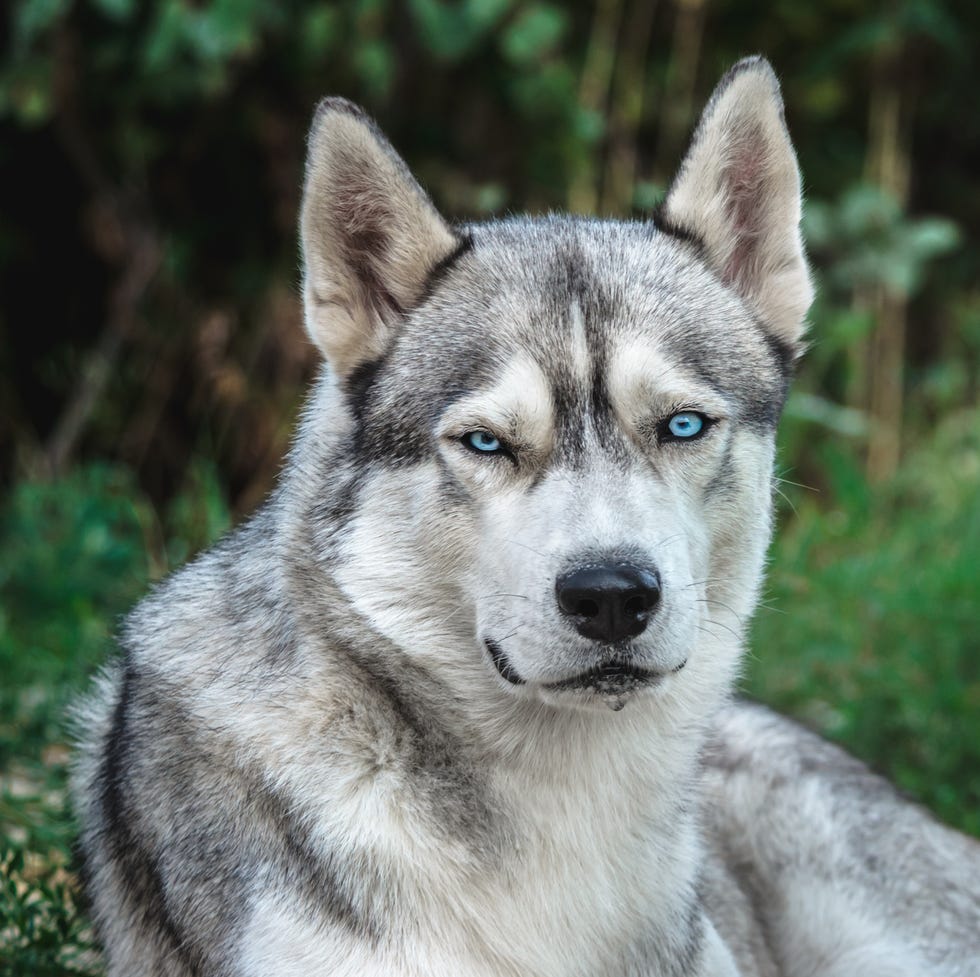
Although they resemble Huskies,”Purebred Alaskan Malamutes should not have blue eyes, and this trait disqualifies them in the show ring,” says Dr. Dockweiler. Still, if you’d like a blue-eyed dog from a mostly Malamute bloodline (probably with a smidge of Sib mixed in), it shouldn’t be too difficult to find one. Bigger and stronger than their cousin, this breed is named after the native Inuit tribe that developed it to haul sleds and is surprisingly gentle and friendly for such a powerful, traditionally hard-working pup.
Group: WorkingHeight: 25 inches Weight: 85 poundsEnergy level: HighLife Expectancy: 10–14 years
Jill Gleeson is a travel journalist and memoirist based in the Appalachian Mountains of western Pennsylvania who has written for websites and publications including Good Housekeeping, Woman’s Day, Country Living, Washingtonian, Gothamist, Canadian Traveller, and EDGE Media Network. Jill is the travel editor for Enchanted Living. Learn more about her journey at gleesonreboots.com.

Dr. Jenna Dockweiler, DVM, DACT, is a veterinary geneticist with Embark. She is a board-certified theriogenologist, certified canine rehabilitation therapist, and certified veterinary acupuncture therapist.
Advertisement – Continue Reading Below
Advertisement – Continue Reading Below
Advertisement – Continue Reading Below


